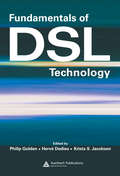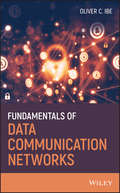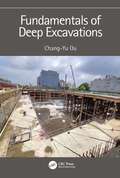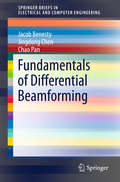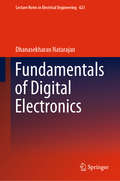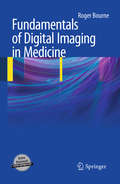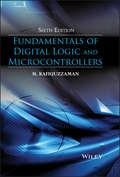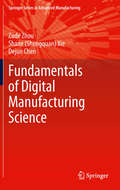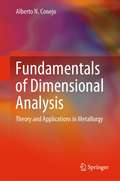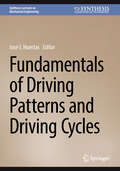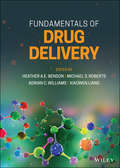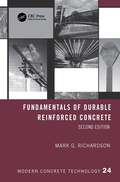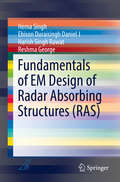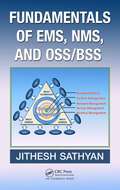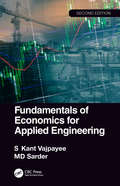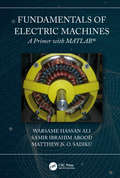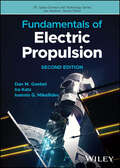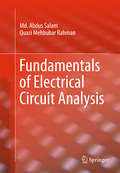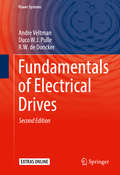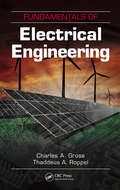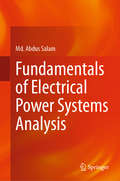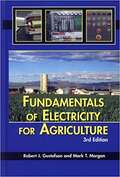- Table View
- List View
Fundamentals of DSL Technology
by Hervé Dedieu Philip Golden Krista JacobsenThe DSL arena is expanding rapidly, making it highly unlikely that any single author can adequately address the breadth and depth of the subject. Responding to the demand of designers worldwide, Fundamentals of DSL Technology combines the strengths of the field's most renowned DSL experts, providing a foundation of all aspects of DSL system design.
Fundamentals of Data Communication Networks
by Oliver C. IbeWhat every electrical engineering student and technical professional needs to know about data exchange across networks While most electrical engineering students learn how the individual components that make up data communication technologies work, they rarely learn how the parts work together in complete data communication networks. In part, this is due to the fact that until now there have been no texts on data communication networking written for undergraduate electrical engineering students. Based on the author’s years of classroom experience, Fundamentals of Data Communication Networks fills that gap in the pedagogical literature, providing readers with a much-needed overview of all relevant aspects of data communication networking, addressed from the perspective of the various technologies involved. The demand for information exchange in networks continues to grow at a staggering rate, and that demand will continue to mount exponentially as the number of interconnected IoT-enabled devices grows to an expected twenty-six billion by the year 2020. Never has it been more urgent for engineering students to understand the fundamental science and technology behind data communication, and this book, the first of its kind, gives them that understanding. To achieve this goal, the book: Combines signal theory, data protocols, and wireless networking concepts into one text Explores the full range of issues that affect common processes such as media downloads and online games Addresses services for the network layer, the transport layer, and the application layer Investigates multiple access schemes and local area networks with coverage of services for the physical layer and the data link layer Describes mobile communication networks and critical issues in network security Includes problem sets in each chapter to test and fine-tune readers’ understanding Fundamentals of Data Communication Networks is a must-read for advanced undergraduates and graduate students in electrical and computer engineering. It is also a valuable working resource for researchers, electrical engineers, and technical professionals.
Fundamentals of Deep Excavations
by Chang-Yu OuExcavation is an important segment of foundation engineering (e.g., in the construction of the foundations or basements of high-rise buildings, underground oil tanks, or subways). However, the excavation knowledge introduced in most books on foundation engineering is too simple to handle actual excavation analysis and design. Moreover, with economic development and urbanization, excavations go deeper and are larger in scale. These conditions require elaborate analysis, design methods and construction technologies. This book is aimed at both theoretical explication and practical application. From basic to advanced, this book attempts to achieve theoretical rigor and consistency. Each chapter is followed by a problem set so that the book can be readily taught at senior undergraduate and graduate levels. The solution to the problems at the end of the chapters can be found on the website (http://www.ct.ntust.edu.tw/ou/). On the other hand, the analysis methods introduced in the book can be used in actual analysis and design as they contain the most up-to-date knowledge. Therefore, this book is suitable for teachers who teach foundation engineering and/or deep excavation courses and engineers who are engaged in excavation analysis and design.
Fundamentals of Differential Beamforming
by Jacob Benesty Jingdong Chen Chao PanThis book provides a systematic study of the fundamental theory and methods of beamforming with differential microphone arrays (DMAs), or differential beamforming in short. It begins with a brief overview of differential beamforming and some popularly used DMA beampatterns such as the dipole, cardioid, hypercardioid, and supercardioid, before providing essential background knowledge on orthogonal functions and orthogonal polynomials, which form the basis of differential beamforming. From a physical perspective, a DMA of a given order is defined as an array that measures the differential acoustic pressure field of that order; such an array has a beampattern in the form of a polynomial whose degree is equal to the DMA order. Therefore, the fundamental and core problem of differential beamforming boils down to the design of beampatterns with orthogonal polynomials. But certain constraints also have to be considered so that the resulting beamformer does not seriously amplify the sensors' self noise and the mismatches among sensors. Accordingly, the book subsequently revisits several performance criteria, which can be used to evaluate the performance of the derived differential beamformers. Next, differential beamforming is placed in a framework of optimization and linear system solving, and it is shown how different beampatterns can be designed with the help of this optimization framework. The book then presents several approaches to the design of differential beamformers with the maximum DMA order, with the control of the white noise gain, and with the control of both the frequency invariance of the beampattern and the white noise gain. Lastly, it elucidates a joint optimization method that can be used to derive differential beamformers that not only deliver nearly frequency-invariant beampatterns, but are also robust to sensors' self noise.
Fundamentals of Digital Communication
by Upamanyu MadhowThis is a concise presentation of the concepts underlying the design of digital communication systems, without the detail that can overwhelm students. Many examples, from the basic to the cutting-edge, show how the theory is used in the design of modern systems and the relevance of this theory will motivate students. The theory is supported by practical algorithms so that the student can perform computations and simulations. Leading edge topics in coding and wireless communication make this an ideal text for students taking just one course on the subject. Fundamentals of Digital Communications has coverage of turbo and LDPC codes in sufficient detail and clarity to enable hands-on implementation and performance evaluation, as well as 'just enough' information theory to enable computation of performance benchmarks to compare them against. Other unique features include space-time communication and geometric insights into noncoherent communication and equalization.
Fundamentals of Digital Electronics (Lecture Notes in Electrical Engineering #623)
by Dhanasekharan NatarajanThis book presents the fundamentals of digital electronics in a focused and comprehensivemanner with many illustrations for understanding of the subject with high clarity. DigitalSignal Processing (DSP) application information is provided for many topics of the subjectto appreciate the practical significance of learning. To summarize, this book lays afoundation for students to become DSP engineers.
Fundamentals of Digital Imaging in Medicine
by Roger BourneIn general, image processing texts are intended for students of engineering and computer science, and there is little written at all on the specific requirements of medical image processing. Students of medical radiation science (Diagnostic radiography, Nuclear medicine, Radiation therapy) usually have minimal mathematical and computer science training and find the available texts incomprehensible. A text that explains the principles of image processing in minimally-mathematical language is needed for these students. Contrary to the claims of some textbook authors, the vast majority of technologists that process images do not need to understand the mathematics involved, but would nevertheless benefit from a thorough understanding of the general process.
Fundamentals of Digital Logic and Microcontrollers
by M. RafiquzzamanReviews of the Fifth Edition:"...a well-established text for undergraduate and graduate students...a good reference for engineers." (IEEE Circuits & Devices Magazine, November/December 2006)"...will serve very well for a number of courses in electrical and computing engineering...can also be used as a reference by practicing engineers who want to know about microcomputers." (Computing Reviews.com, December 14, 2005)"Long recognized for its clear and simple presentation of the principles and basic tools required to design typical digital systems..." (IEEE Computer Magazine, August 2005)While technological change advancing at such a rapid pace, it should come as no surprise that microcontrollers are playing an increasingly important role in the design of digital systems. An understanding of the basic principles of microcontrollers is just one of the enhancements featured in the 6th Edition of Fundamentals of Digital Logic and Microcontrollers. Widely praised by both students and experts alike for its clear and simple presentation of the basic principles and necessary tools required to design typical digital systems, this new edition is entirely updated and revised to reflect the latest advances in contemporary digital design. The text's primary focus remains on computer design at the device, logic, and system levels while covering such basic points as number systems and Boolean algebra, combinational and sequential logic design. More advanced topics such as computer architecture and microcontroller-based applications are also addressed. Simplified coverage of basic concepts associated with CPLDs and FPGAs is included. Fundamentals of Digital Logic and Microcontrollers, 6th Edition, solidifies its reputation as the most invaluable and accessible introduction to the principles of digital system design available today.Numerous examples are provided throughout the text, including a complete tutorial for compiling and debugging a C-Program using the MPLAB. A solutions manual is available to instructors who adopt this text for a university course.
Fundamentals of Digital Manufacturing Science
by Dejun Chen Shane Shengquan Xie Zude ZhouThe manufacturing industry will reap significant benefits from encouraging the development of digital manufacturing science and technology. Digital Manufacturing Science uses theorems, illustrations and tables to introduce the definition, theory architecture, main content, and key technologies of digital manufacturing science. Readers will be able to develop an in-depth understanding of the emergence and the development, the theoretical background, and the techniques and methods of digital manufacturing science. Furthermore, they will also be able to use the basic theories and key technologies described in Digital Manufacturing Science to solve practical engineering problems in modern manufacturing processes. Digital Manufacturing Science is aimed at advanced undergraduate and postgraduate students, academic researchers and researchers in the manufacturing industry. It allows readers to integrate the theories and technologies described with their own research works, and to propose new ideas and new methods to improve the theory and application of digital manufacturing science.
Fundamentals of Dimensional Analysis: Theory and Applications in Metallurgy
by Alberto N. ConejoThis is the first book which systematically describes an integral approach on dimensional analysis. The amount of textbooks on dimensional analysis is huge, however most of the books start with the definition of the relevant variables. When the variables are given to the reader without prior knowledge on each problem it has serious consequences: the usefulness of dimensional analysis is not appreciated, is not possible to understand the real challenges of this subject and the result, which is a general relationship with dimensionless groups is useless. This book closes the hole in previous books because in addition to describe step by step how to reach the general relationship with dimensionless groups, which creates solid basis of different metallurgical problems to understand the role of the relevant variables. It provides a full description on how to obtain the experimental data and applies the experimental data to transform the general relationship in a particular solution. Once the reader learns how to design the experimental work and uses that information to define the particular solution, it is possible to asses if the selection of variables was adequate or not. The book is useful for both undergraduate and graduate students.
Fundamentals of Driving Patterns and Driving Cycles (Synthesis Lectures on Mechanical Engineering)
by José I. HuertasA driving cycles (DC) is a speed profile that represents the driving pattern of a given region or country. It is used to evaluate the vehicles energy consumption and emissions, as well as a tool to design vehicle powertrains and to evaluate strategies related energy management and logistics in several applications that involve the use of motorized vehicles. This book provides a comprehensive and general methodology to construct and assess DCs for motorized vehicles in a given region. Different techniques and methodologies for data collection and processing are presented, as well as new technologies and tendencies related to DCs are included and discussed. As an example, different case studies performed in Latin-American are presented and discussed.
Fundamentals of Drug Delivery
by Heather A E BensonA comprehensive guide to the current research, major challenges, and future prospects of controlled drug delivery systems Controlled drug delivery has the potential to significantly improve therapeutic outcomes, increase clinical benefits, and enhance the safety of drugs in a wide range of diseases and health conditions. Fundamentals of Drug Delivery provides comprehensive and up-to-date coverage of the essential principles and processes of modern controlled drug delivery systems. Featuring contributions by respected researchers, clinicians, and pharmaceutical industry professionals, this edited volume reviews the latest research in the field and addresses the many issues central to the development of effective, controlled drug delivery. Divided in three parts, the book begins by introducing the concept of drug delivery and discussing both challenges and opportunities within the rapidly evolving field. The second section presents an in-depth critique of the common administration routes for controlled drug delivery, including delivery through skin, the lungs, and via ocular, nasal, and otic routes. The concluding section summarizes the current state of the field and examines specific issues in drug delivery and advanced delivery technologies, such as the use of nanotechnology in dermal drug delivery and advanced drug delivery systems for biologics. This authoritative resource: Covers each main stage of the drug development process, including selecting pharmaceutical candidates and evaluating their physicochemical characteristics Describes the role and application of mathematical modelling and the influence of drug transporters in pharmacokinetics and drug disposition Details the physiology and barriers to drug delivery for each administration route Presents a historical perspective and a look into the possible future of advanced drug delivery systems Explores nanotechnology and cell-mediated drug delivery, including applications for targeted delivery and toxicological and safety issues Includes comprehensive references and links to the primary literature Edited by a team of of internationally-recognized experts, Fundamentals of Drug Delivery is essential reading for researchers, industrial scientists, and advanced students in all areas of drug delivery including pharmaceutics, pharmaceutical sciences, biomedical engineering, polymer and materials science, and chemical and biochemical engineering.
Fundamentals of Durable Reinforced Concrete (Modern Concrete Technology #24)
by Mark G. RichardsonThis new edition sets out the fundamental aspects of concrete durability with an emphasis on sustainability and carbon neutrality through performance-based methodologies. Global approaches to managing durability are explained from both a prescriptive and performance viewpoint. Achieving a balance between the interactive factors influencing durability and sustainability is supported by an explanation of the physical and chemical phenomena at play, determination of key performance parameters by mathematical modelling and physical testing, and current guidance for good practice. New chapters and sections examine the holistic approach to durability and significant aspects of traditional and new cementitious systems. The full range of threats to durability are covered in this single volume, including reinforcement corrosion, carbonation, chloride ingress, freeze-thaw effects, sulfate attack, acid and seawater attack, alkali-aggregate reaction, cracking, abrasion, erosion, cavitation, and weathering. The book presents a framework for specification through internationally adopted codes and standards and summarises the background to probabilistic approaches to durability design, providing a state-of-the-art review of mathematical modelling of deterioration mechanisms along with current directions in test methods for performance-based specifications. Fundamentals of Durable Reinforced Concrete is an essential reference on concrete durability for specifiers and researchers and is also accessible to undergraduate students.
Fundamentals of EM Design of Radar Absorbing Structures (RAS)
by Hema Singh Harish Singh Rawat Ebison Duraisingh Daniel J Reshma GeorgeThis book presents a detailed analytical formulation, and step-by-step design procedure for the electromagnetic (EM) design of radar absorbing structures (RAS). It discusses both the equivalent circuit model and Smith chart approach with illustrations to provide a clear understanding of the steps involved in designing multilayered RAS according to the desired specifications. This book is a valuable resource for beginners, academicians, and R&D engineers working in the field of RAS design and development.
Fundamentals of EMS, NMS and OSS/BSS
by Jithesh SathyanIn this era where data and voice services are available at a push of a button, service providers have virtually limitless options for reaching their customers with value-added services. The changes in services and underlying networks that this always-on culture creates make it essential for service providers to understand the evolving business logi
Fundamentals of Economics for Applied Engineering
by S. Vajpayee Md SarderAn easy-to-follow contemporary engineering economics text that helps making sound economic decisions without advanced mathematics. <P><P>This one-semester introduction to the fundamentals of engineering economics provides an overview of the basic theory and mathematics underlying operational business decisions that engineering technology, engineering, and industrial technology students will face in the workplace. A basic knowledge of economics empowers a manager to balance costs with production. <P><P>This new edition of Fundamentals of Economics for Engineering Technologists and Engineers is written in plain language. Concepts have been simplified and kept straightforward with an emphasis on "how to apply" economic principles. <P><P>Practical examples as a tool for managing business data and giving detailed analysis of business operations. throughout the text make good use of Microsoft Excel templates, provided on the book’s companion website, for students. Chapter-end exercises provide discussion and multiple-choice questions along with numerical problems, and a solutions manual and instructor resources is given for adopting instructors.
Fundamentals of Ecotoxicology: The Science of Pollution, Fifth Edition
by Michael C. NewmanThis new edition is revised throughout and includes new and expanded information on natural resource damage assessment, the latest emerging contaminants and issues, and adds new international coverage, including case studies and rules and regulations. The text details key environmental contaminants, explores their fates in the biosphere, and discusses bioaccumulation and the effects of contaminants at increasing levels of ecological organization. Vignettes written by experts illustrate key themes or highlight especially pertinent examples. This edition offers an instructors' solution manual, PowerPoint slides, and supplemental images. Features: Adds all new discussions of natural resource damage assessment concepts and approaches Includes new vignettes written by leading guest authors Draws on materials from 2,500 cited sources, including 400+ new to this edition Adds numerous new entries to a useful glossary of 800+ terms Includes a new appendix discussing Brazilian environmental laws and regulations added to existing appendices outlining U.S., E.U., Chinese, Australian, and Indian environmental laws Fundamentals of Ecotoxicology: The Science of Pollution, Fifth Edition contains a broad overview of ecotoxicology and provides a basic understanding of the field. Designed as a textbook for use in introductory graduate or upper-level undergraduate courses in ecotoxicology, applied ecology, environmental pollution, and environmental science, it can also be used as a general reference for practicing environmental toxicologists.
Fundamentals of Electric Machines: A Primer with MATLAB
by Matthew N. Sadiku Warsame Hassan Ali Samir AboodAn electric machine is a device that converts mechanical energy into electrical energy or vice versa. It can take the form of an electric generator, electric motor, or transformer. Electric generators produce virtually all electric power we use all over the world. Electric machine blends the three major areas of electrical engineering: power, control and power electronics. This book presents the relation of power quantities for the machine as the current, voltage power flow, power losses, and efficiency. This book will provide a good understanding of the behavior and its drive, beginning with the study of salient features of electrical dc and ac machines.
Fundamentals of Electric Power Engineering: From Electromagnetics to Power Systems
by Massimo Ceraolo Davide PoliThis book serves as a tool for any engineer who wants to learn about circuits, electrical machines and drives, power electronics, and power systems basics From time to time, engineers find they need to brush up on certain fundamentals within electrical engineering. This clear and concise book is the ideal learning tool for them to quickly learn the basics or develop an understanding of newer topics. Fundamentals of Electric Power Engineering: From Electromagnetics to Power Systems helps nonelectrical engineers amass power system information quickly by imparting tools and trade tricks for remembering basic concepts and grasping new developments. Created to provide more in-depth knowledge of fundamentals—rather than a broad range of applications only—this comprehensive and up-to-date book: Covers topics such as circuits, electrical machines and drives, power electronics, and power system basics as well as new generation technologies Allows nonelectrical engineers to build their electrical knowledge quickly Includes exercises with worked solutions to assist readers in grasping concepts found in the book Contains “in-depth” side bars throughout which pique the reader’s curiosity Fundamentals of Electric Power Engineering is an ideal refresher course for those involved in this interdisciplinary branch. For supplementary files for this book, please visit http://booksupport.wiley.com
Fundamentals of Electric Propulsion: Ion And Hall Thrusters (JPL Space Science and Technology Series #1)
by Dan M. Goebel Ira Katz Ioannis G. MikellidesFundamentals of Electric Propulsion Understand the fundamental basis of spaceflight with this cutting-edge guide As spacecraft engineering continues to advance, so too do the propulsion methods by which human beings can seek out the stars. Ion thrusters and Hall thrusters have been the subject of considerable innovation in recent years, and spacecraft propulsion has never been more efficient. For professionals within and adjacent to spacecraft engineering, this is critical knowledge that can alter the future of space flight. Fundamentals of Electric Propulsion offers a thorough grounding in electric propulsion for spacecraft, particularly the features and mechanisms underlying Ion and Hall thrusters. Updated in the light of rapidly expanding knowledge, the second edition of this essential guide detailed coverage of thruster principles, plasma physics, and more. It reflects the historic output of the legendary Jet Propulsion Laboratory and promises to continue as a must-own volume for spacecraft engineering professionals. Readers of the second edition of Fundamentals of Electric Propulsion readers will also find: Extensive updates to chapters covering hollow cathodes and Hall thrusters, based on vigorous recent research New sections covering magnetic shielding, cathode plume instabilities, and more Figures and homework problems in each chapter to facilitate learning and retention Fundamentals of Electric Propulsion is an essential work for spacecraft engineers and researchers working in spacecraft propulsion and related fields, as well as graduate students in electric propulsion, aerospace science, and space science courses.
Fundamentals of Electrical Circuit Analysis
by Md. Abdus Salam Quazi Mehbubar RahmanThis book is designed as an introductory course for undergraduate students, in Electrical and Electronic, Mechanical, Mechatronics, Chemical and Petroleum engineering, who need fundamental knowledge of electrical circuits. Worked out examples have been presented after discussing each theory. Practice problems have also been included to enrich the learning experience of the students and professionals. PSpice and Multisim software packages have been included for simulation of different electrical circuit parameters. A number of exercise problems have been included in the book to aid faculty members.
Fundamentals of Electrical Drives
by Andre Veltman Duco W.J. Pulle Rik W. De DonckerThe purpose of this book is to familiarize the reader with all aspects of electrical drives. It contains a comprehensive user-friendly introductory text.
Fundamentals of Electrical Engineering
by Charles A. Gross Thaddeus A. RoppelReal-world engineering problems are rarely, if ever, neatly divided into mechanical, electrical, chemical, civil, and other categories. Engineers from all disciplines eventually encounter computer and electronic controls and instrumentation, which require at least a basic knowledge of electrical and other engineering specialties, as well as associa
Fundamentals of Electrical Power Systems Analysis
by Md. Abdus SalamThis book covers the topic from introductory to advanced levels for undergraduate students of Electrical Power and related fields, and for professionals who need a fundamental grasp of power systems engineering. The book also analyses and simulates selected power circuits using appropriate software, and includes a wealth of worked-out examples and practice problems to enrich readers’ learning experience. In addition, the exercise problems provided can be used in teaching courses.
Fundamentals of Electricity for Agriculture
by Robert J. Gustafson Mark T. MorganAuthored by Robert J. Gustafson and Mark T. Morgan. Designed to assist the reader in attaining a basic understanding of the nature of electricity and in developing skills in solving problems associated with applying electricity in agriculture. <p><p>The first chapters lay the foundation in the basics of electricity. The second portion of the book deals with applications and devices commonly found in agricultural uses of electricity.
